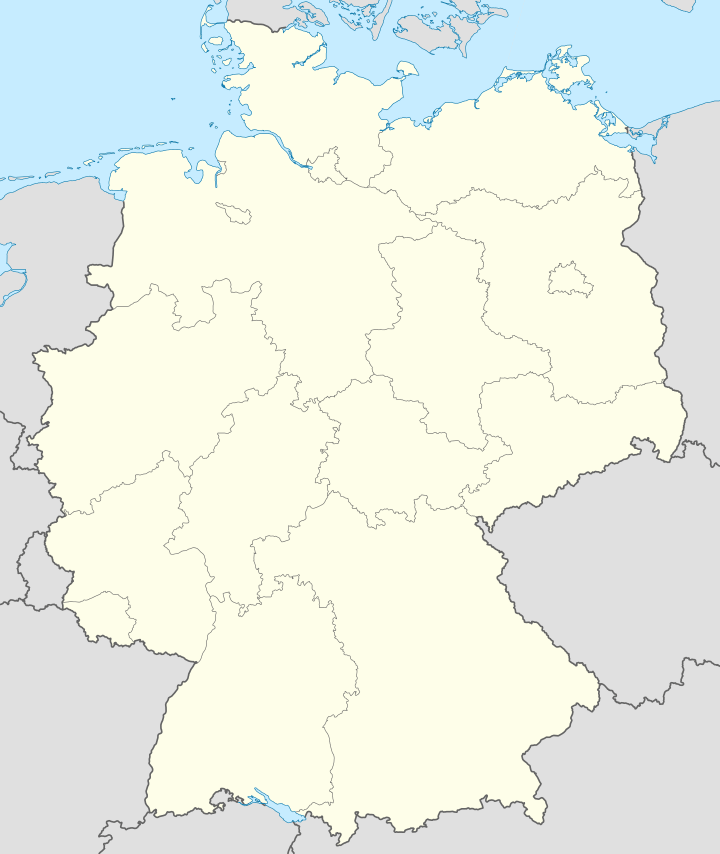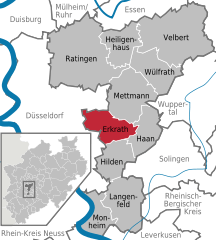Erkrath
| Erkrath | ||
|---|---|---|
| ||
 Erkrath | ||
Location of Erkrath within Mettmann district 
 | ||
| Coordinates: 51°13′26″N 06°54′53″E / 51.22389°N 6.91472°ECoordinates: 51°13′26″N 06°54′53″E / 51.22389°N 6.91472°E | ||
| Country | Germany | |
| State | North Rhine-Westphalia | |
| Admin. region | Düsseldorf | |
| District | Mettmann | |
| Government | ||
| • Mayor | Arno Werner (CDU) | |
| Area | ||
| • Total | 26.89 km2 (10.38 sq mi) | |
| Population (2013-12-31)[1] | ||
| • Total | 43,639 | |
| • Density | 1,600/km2 (4,200/sq mi) | |
| Time zone | CET/CEST (UTC+1/+2) | |
| Postal codes | 40699 | |
| Dialling codes | 0211, 02104, 02129, 02103 | |
| Vehicle registration | ME | |
| Website | www.erkrath.de | |
Erkrath is a town in the district of Mettmann, in North Rhine-Westphalia, Germany
Geography
Erkrath is situated on Düssel river, directly east of Düsseldorf and west of Wuppertal, close to the famous Neandertal. It has two stations, Erkrath station, which is served by Rhine-Ruhr S-Bahn line S 8, and Erkrath Nord station, which is served by S-Bahn line S 28, both at 20 minute intervals.
In that part of Neanderthal, which is located in Erkrath, in the summer of 1856, quarry workers discovered the fossilised remains of what became known as the Neanderthal man or Homo Neanderthalensis in Feldhof cave.
History
Erkrath is known since 1148 and received the city rights in 1966. In 1975, the municipality of Hochdahl was incorporated into Erkrath. As well its former borough Unterbach was incorporated into Düsseldorf. Only a part of Unterbach called Unterfeldhaus remained as now a borough of its own with Erkrath. Erkrath today has three local parts: Erkrath, Hochdahl and Unterfeldhaus.
Gallery
-

Heilig-Geist-Kirche (Erkrath)
-
Neanderkirche (Erkrath)
Twin towns
-
 Cergy-Pontoise, France
Cergy-Pontoise, France -
 West Lancashire, England
West Lancashire, England -
 Leinefelde in Thuringia (friendship)
Leinefelde in Thuringia (friendship) -
 Port-de-Paix, Haiti (sponsorship)
Port-de-Paix, Haiti (sponsorship)
Notable people
- Klaus Allofs, former German footballer
- Thomas Allofs, former German footballer
- Toni Turek former German footballer (World Champion 1954)
References
- ↑ "Amtliche Bevölkerungszahlen". Landesbetrieb Information und Technik NRW (in German). 4 September 2014.
External links
| Wikimedia Commons has media related to Erkrath-Hochdahl. |
- Official site (German)
- Homepage of the Neanderthal Museum (German)
- Homepage of the Lokschuppen Museum (German)
| ||||||||

